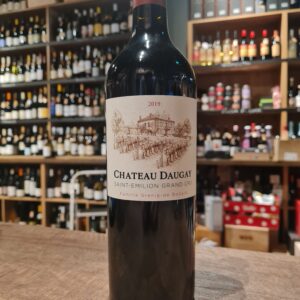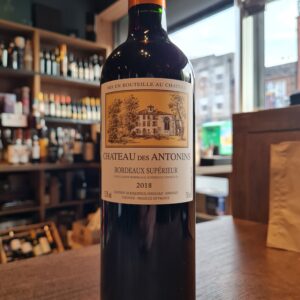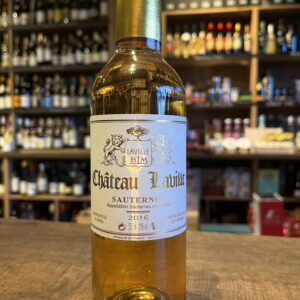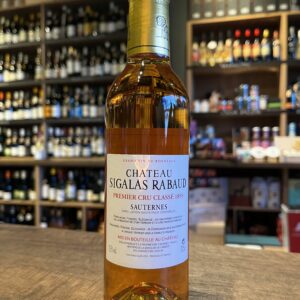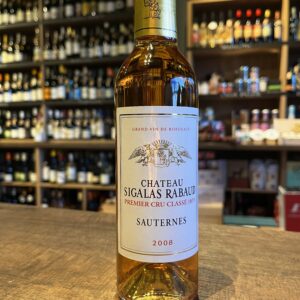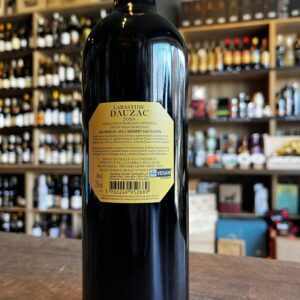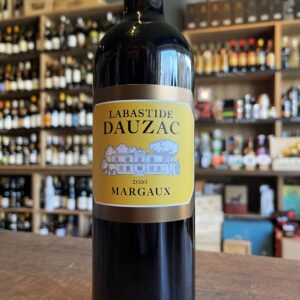-
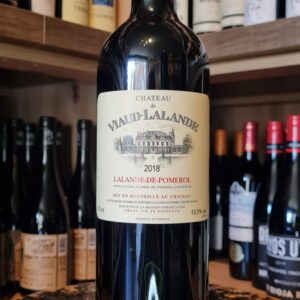 Chateau Viaud Lalande is a small-scale venture of the Durand – Teyssier family who have been making wine in the village of Puisseguin, appellation of Lalande de Pomerol, for three generations. 1.5 hectares of vineyards adjoining the Chateau were planted by Philippe Durand – Teyssier back in the 60’s. Typically for the region, those are mostly Merlot and Cabernet Franc well suited to the local, clay dominated soils. Since 2007 Philippe has handed over the wine making and day-to-day running of the property to his son Thomas. Having previously worked in prominent 1er and Grand Cru Classé estates in Saint Emilion (Château Belair, Château Cadet Bon), Thomas is continuing family tradition, with clear focus on quality. Annual production: 9000 bottles.
Chateau Viaud Lalande is a small-scale venture of the Durand – Teyssier family who have been making wine in the village of Puisseguin, appellation of Lalande de Pomerol, for three generations. 1.5 hectares of vineyards adjoining the Chateau were planted by Philippe Durand – Teyssier back in the 60’s. Typically for the region, those are mostly Merlot and Cabernet Franc well suited to the local, clay dominated soils. Since 2007 Philippe has handed over the wine making and day-to-day running of the property to his son Thomas. Having previously worked in prominent 1er and Grand Cru Classé estates in Saint Emilion (Château Belair, Château Cadet Bon), Thomas is continuing family tradition, with clear focus on quality. Annual production: 9000 bottles. -
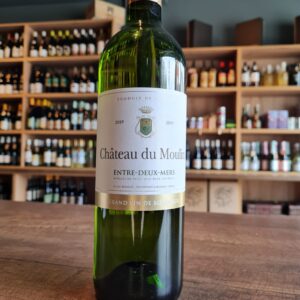 A thoroughly delightful white Bordeaux, made from a blend of Semillon, Sauvignon Blanc, and Muscadelle. Very aromatic with notes of white peach and fresh garden herbs, highlighted with bright citrus rind and mineral nuances. Easy breazy, this is lovely go-to summer wine to enjoy as an aperitif or with seafood dishes. YUM!
A thoroughly delightful white Bordeaux, made from a blend of Semillon, Sauvignon Blanc, and Muscadelle. Very aromatic with notes of white peach and fresh garden herbs, highlighted with bright citrus rind and mineral nuances. Easy breazy, this is lovely go-to summer wine to enjoy as an aperitif or with seafood dishes. YUM! -
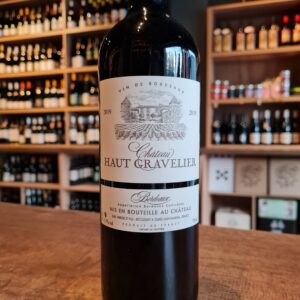 Located within the AOC Bordeaux, the Vignoble de Gravelierhas 32 Ha of vines with an average age of 20 years. It is located on hillsides thus benefiting from a beautiful sunshine. The harvest is harvested at perfect maturity and vinified using the traditional method in stainless steel vats and aged in cement vats. The grape variety of the vineyard is composed of 75% Merlot and 25% Cabernet-Sauvignon. To present a quality wine, the yields and phytosanitary treatments are moderate. The foliage is kept as high as possible to obtain better maturity. With deep colour, classic structure and unusually ripe flavours, this is classic claret to serve with roast beef, duck or T-bone steak. A gourmet Bordeaux!
Located within the AOC Bordeaux, the Vignoble de Gravelierhas 32 Ha of vines with an average age of 20 years. It is located on hillsides thus benefiting from a beautiful sunshine. The harvest is harvested at perfect maturity and vinified using the traditional method in stainless steel vats and aged in cement vats. The grape variety of the vineyard is composed of 75% Merlot and 25% Cabernet-Sauvignon. To present a quality wine, the yields and phytosanitary treatments are moderate. The foliage is kept as high as possible to obtain better maturity. With deep colour, classic structure and unusually ripe flavours, this is classic claret to serve with roast beef, duck or T-bone steak. A gourmet Bordeaux! -
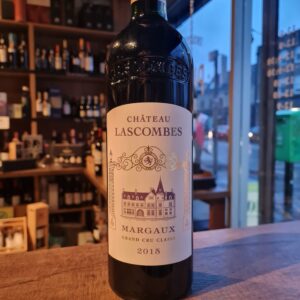 The iconic, ivy-covered Château Lascombes is one of the most recognizable structures in all of Margaux. One would never expect this picturesque and secluded estate to have one of the largest vineyards in the Médoc. The vineyard is an astounding 120 hectares primarily located in Margaux; with 10 hectares in the Haut-Médoc appellation. With a staff of 36, one can imagine the harvest period on such a vast estate would be difficult to manage. Because of their access to state-of-the-art technology and some of the most desirable plots in Margaux, the viticultural team of Château Lascombes produces wines that continue to impress and receive critical acclaim. Château Lascombes earned its namesake after its owner, Antoine Chevalier de Lascombes in 1625. The estate was inherited from the Durfort de Duras family who also owned Château Durfort – later known as the famed Second Growth property, Château Durfort-Vivens. Château Lascombes was classified as a Second Growth estate in 1855, but its history really began when it was purchased almost a hundred years later. Alexis Lichine and a group of investors – including the wealthy American, David Rockefeller – purchased the estate in 1952. There is a diverse array of soil types at Château Lascombes. Gravelly outcroppings are planted with Cabernet Sauvignon and Petit Verdot. The property also has limestone terroir, which is highly unique to the Margaux region. It is the areas with clay and limestone where the primary varietal at Château Lascombes, Merlot, really shines. Château Lascombes has 50% of its vineyard planted with Merlot – an unusual choice for an estate in Margaux. The vines are on average 35 years old, and only 50-hectares of the sprawling vineyard are considered able to produce the wines of top Second Growth quality. The estate is presently managed by Dominique Befve, who brings his expertise from ten years as technical director at Château Lafite Rothschild and Duhart Milon. Upon his arrival, Dominique oversaw major technical innovations to the cellar. The cellar astonishes visitors with its signature blue lights and technologically advanced Oxoline racks. The racks rotate the barrels and keep the lees of the wine in suspension, reducing oxidation and making the wine round and more immediately accessible. Open at least 1 hour before tasting, this Margaux finesse will be preferred at the time of entry (meat) or on your cheese board (soft and hard pasta).
The iconic, ivy-covered Château Lascombes is one of the most recognizable structures in all of Margaux. One would never expect this picturesque and secluded estate to have one of the largest vineyards in the Médoc. The vineyard is an astounding 120 hectares primarily located in Margaux; with 10 hectares in the Haut-Médoc appellation. With a staff of 36, one can imagine the harvest period on such a vast estate would be difficult to manage. Because of their access to state-of-the-art technology and some of the most desirable plots in Margaux, the viticultural team of Château Lascombes produces wines that continue to impress and receive critical acclaim. Château Lascombes earned its namesake after its owner, Antoine Chevalier de Lascombes in 1625. The estate was inherited from the Durfort de Duras family who also owned Château Durfort – later known as the famed Second Growth property, Château Durfort-Vivens. Château Lascombes was classified as a Second Growth estate in 1855, but its history really began when it was purchased almost a hundred years later. Alexis Lichine and a group of investors – including the wealthy American, David Rockefeller – purchased the estate in 1952. There is a diverse array of soil types at Château Lascombes. Gravelly outcroppings are planted with Cabernet Sauvignon and Petit Verdot. The property also has limestone terroir, which is highly unique to the Margaux region. It is the areas with clay and limestone where the primary varietal at Château Lascombes, Merlot, really shines. Château Lascombes has 50% of its vineyard planted with Merlot – an unusual choice for an estate in Margaux. The vines are on average 35 years old, and only 50-hectares of the sprawling vineyard are considered able to produce the wines of top Second Growth quality. The estate is presently managed by Dominique Befve, who brings his expertise from ten years as technical director at Château Lafite Rothschild and Duhart Milon. Upon his arrival, Dominique oversaw major technical innovations to the cellar. The cellar astonishes visitors with its signature blue lights and technologically advanced Oxoline racks. The racks rotate the barrels and keep the lees of the wine in suspension, reducing oxidation and making the wine round and more immediately accessible. Open at least 1 hour before tasting, this Margaux finesse will be preferred at the time of entry (meat) or on your cheese board (soft and hard pasta). -
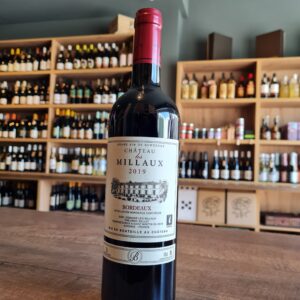 With a very good structure and fine crimson colour, this Bordeaux Supérieur is a really pleasant wine to drink.The merlot dominant variety offers extraordinary fruitiness with mellow tannins resulting in supple wines that are easy to drink. The cabernet sauvignon and cabernet franc gives a good structure to the wine. Aromas of tropical fruits and red fruits give a complex bouquet. All these features offer a wine that can be enjoyed with red meats and barbecues.
With a very good structure and fine crimson colour, this Bordeaux Supérieur is a really pleasant wine to drink.The merlot dominant variety offers extraordinary fruitiness with mellow tannins resulting in supple wines that are easy to drink. The cabernet sauvignon and cabernet franc gives a good structure to the wine. Aromas of tropical fruits and red fruits give a complex bouquet. All these features offer a wine that can be enjoyed with red meats and barbecues. -
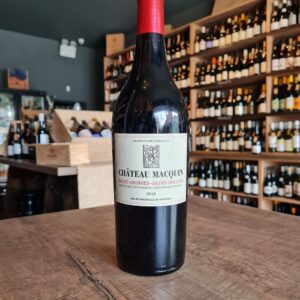 Wines have been made at Château Macquin since 1885, when the first cellar was developed by François-Albert Macquin. François was the first to re-plant vines in the Saint-Émilion region following the phylloxera outbreak in the 19th century. Today, the Château is run by his grandson Denis and wife Christine Corre-Macquin, who own 27 hectares of vines in both Saint-Émilion and Pomerol. They are involved in every vine-growing and winemaking decision to ensure the high quality of their wine remains consistent every vintage. Château Macquin is located just three kilometres north of Saint-Émilion, in the small village of Saint-Georges, the smallest of all Bordeaux appellations (180 hectares). However, at its peak of 89 metres above sea level, Saint-Georges enjoys one of the best elevations on the right bank, giving the wines freshness and concentration. The south facing vines are planted on clay and limestone soils and range from 15 to 60 years old. The vines are sustainably farmed, without the use of herbicides, fertilisers, or other harmful chemicals. The outstanding weather conditions in August and subsequent Indian summer resulted in red wine grapes with a particularly high sugar content, satisfactory levels of tartaric acid and promising aromatic potential. The thick skins and concentration of tannins required meticulous care during extraction. The Merlot wines are deep and concentrated,while maintaining freshness in spite of their relatively high alcohol level. Enjoyed with Ratatouille, Tournedos, grilled lamb chops.
Wines have been made at Château Macquin since 1885, when the first cellar was developed by François-Albert Macquin. François was the first to re-plant vines in the Saint-Émilion region following the phylloxera outbreak in the 19th century. Today, the Château is run by his grandson Denis and wife Christine Corre-Macquin, who own 27 hectares of vines in both Saint-Émilion and Pomerol. They are involved in every vine-growing and winemaking decision to ensure the high quality of their wine remains consistent every vintage. Château Macquin is located just three kilometres north of Saint-Émilion, in the small village of Saint-Georges, the smallest of all Bordeaux appellations (180 hectares). However, at its peak of 89 metres above sea level, Saint-Georges enjoys one of the best elevations on the right bank, giving the wines freshness and concentration. The south facing vines are planted on clay and limestone soils and range from 15 to 60 years old. The vines are sustainably farmed, without the use of herbicides, fertilisers, or other harmful chemicals. The outstanding weather conditions in August and subsequent Indian summer resulted in red wine grapes with a particularly high sugar content, satisfactory levels of tartaric acid and promising aromatic potential. The thick skins and concentration of tannins required meticulous care during extraction. The Merlot wines are deep and concentrated,while maintaining freshness in spite of their relatively high alcohol level. Enjoyed with Ratatouille, Tournedos, grilled lamb chops. -
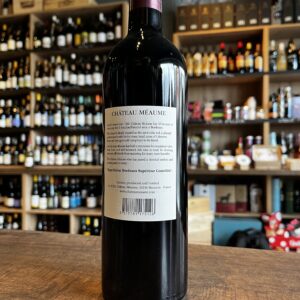
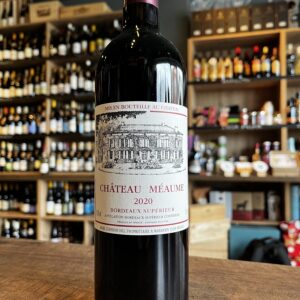 Most of us know Roald Dahl's novels, I for one have read them countless times. Firstly to my eldest and now, once in while I try with the middle one, even though he is still a bit young for those books. He is only 4 my wife says! They are just fun to read. To my surprise, after deciding to bring Château Méaume Bordeaux Supérieur to our Pinto Wines portfolio I came across that it was Roald Dahl's favourite wine and per his own words ''simply delicious''. Well I could not put it better myself. It is a fantastic wine, with superb quality at this price point and what some would call a ''Big little wine.'' Unpretentious especially being French and carries a lot with it. It has a warm, expressive black fruits with a serious, rustic, spicy structure. A hint of exotic perfume on the nose, with a luscious, very ripe blackberry and damson palate.80% merlot, with cabernets franc and sauvignon adding a rich, chewy texture. Very more-ish, with freshness, and great balance.Château Méaume, owned by English couple Alan and Sue Johnson-Hill since 1980, is an historic property just 10 miles from the famous vineyards of St-Emilion and Pomerol. The 2016 Vintage is one of the best produced after the 2000's and critics were fast to praise the 2018. Cheers Roald!
Most of us know Roald Dahl's novels, I for one have read them countless times. Firstly to my eldest and now, once in while I try with the middle one, even though he is still a bit young for those books. He is only 4 my wife says! They are just fun to read. To my surprise, after deciding to bring Château Méaume Bordeaux Supérieur to our Pinto Wines portfolio I came across that it was Roald Dahl's favourite wine and per his own words ''simply delicious''. Well I could not put it better myself. It is a fantastic wine, with superb quality at this price point and what some would call a ''Big little wine.'' Unpretentious especially being French and carries a lot with it. It has a warm, expressive black fruits with a serious, rustic, spicy structure. A hint of exotic perfume on the nose, with a luscious, very ripe blackberry and damson palate.80% merlot, with cabernets franc and sauvignon adding a rich, chewy texture. Very more-ish, with freshness, and great balance.Château Méaume, owned by English couple Alan and Sue Johnson-Hill since 1980, is an historic property just 10 miles from the famous vineyards of St-Emilion and Pomerol. The 2016 Vintage is one of the best produced after the 2000's and critics were fast to praise the 2018. Cheers Roald! -
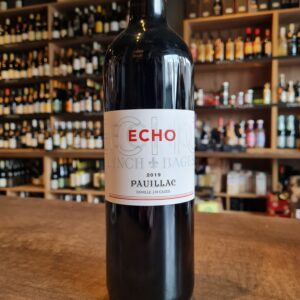 Thomas Lynch was a descendant of the Tribes of Galway. His father John emigrated in 1691 from Galway, Ireland to Bordeaux, inherited an estate in the village of Bages through his wife, Elizabeth, in 1749. This year represents the foundation of Château Lynch-Bages, which Thomas passed on to his son, Jean-Baptiste, upon his marriage in 1779. Jean-Baptiste soon handed over supervision to his brother Michel who maintained responsibility for the Bages estate until 1824, when the family sold it to a Swiss wine merchant, Sebastien Jurine, who had recently moved to Bordeaux. Château Lynch-Bages remained in the hands of the Jurine family, followed by the Cayrou family, for over a hundred years. In 1934, Jean-Charles Cazes rented the property from its then owner, Felix de Vial, subsequently purchasing it in 1938. After Jean-Charles Cazes’ death, aged 95, in 1972, the estate has been largely managed by his grandson, Jean-Michel Cazes.[2] In the late 1980s, the AXA Millésimes group began to develop a portfolio of wine property holdings, and approached Jean-Michel Cazes for help (Claude Bébéar, the AXA President, was a long-time Cazes family friend). They established Châteaux & Associés, which Cazes ran until he reached 65, and which by the end of the twentieth century owned many vineyards across Europe. Ownership of Château Lynch-Bages, however, remains with the Cazes family. In 2017, the Cazes family has acquired Château Haut-Batailley, the 1855 Grand Cru Classé estate in Pauillac. In the interest of sustainable development, agriculture is in every way reasoned: fertilization methods defined precisely and adapted to soil, optimized phytosanitary control, use of sexual confusion against worms of the bunch, controlled grassing of plots for control the vigor of the vine, prolonged rest of the soil by flowering fallow land … The use of neutral products for the environment is everywhere privileged.
Thomas Lynch was a descendant of the Tribes of Galway. His father John emigrated in 1691 from Galway, Ireland to Bordeaux, inherited an estate in the village of Bages through his wife, Elizabeth, in 1749. This year represents the foundation of Château Lynch-Bages, which Thomas passed on to his son, Jean-Baptiste, upon his marriage in 1779. Jean-Baptiste soon handed over supervision to his brother Michel who maintained responsibility for the Bages estate until 1824, when the family sold it to a Swiss wine merchant, Sebastien Jurine, who had recently moved to Bordeaux. Château Lynch-Bages remained in the hands of the Jurine family, followed by the Cayrou family, for over a hundred years. In 1934, Jean-Charles Cazes rented the property from its then owner, Felix de Vial, subsequently purchasing it in 1938. After Jean-Charles Cazes’ death, aged 95, in 1972, the estate has been largely managed by his grandson, Jean-Michel Cazes.[2] In the late 1980s, the AXA Millésimes group began to develop a portfolio of wine property holdings, and approached Jean-Michel Cazes for help (Claude Bébéar, the AXA President, was a long-time Cazes family friend). They established Châteaux & Associés, which Cazes ran until he reached 65, and which by the end of the twentieth century owned many vineyards across Europe. Ownership of Château Lynch-Bages, however, remains with the Cazes family. In 2017, the Cazes family has acquired Château Haut-Batailley, the 1855 Grand Cru Classé estate in Pauillac. In the interest of sustainable development, agriculture is in every way reasoned: fertilization methods defined precisely and adapted to soil, optimized phytosanitary control, use of sexual confusion against worms of the bunch, controlled grassing of plots for control the vigor of the vine, prolonged rest of the soil by flowering fallow land … The use of neutral products for the environment is everywhere privileged. -
Out of stock
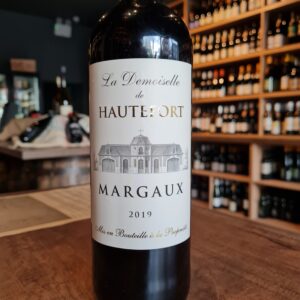 Slender and racy length, beautiful smoothness, noble freshness, very fragrant, without weakness in terms of the body and with the extension of high quality terroirs.
Slender and racy length, beautiful smoothness, noble freshness, very fragrant, without weakness in terms of the body and with the extension of high quality terroirs.


